Sport of Diving – So Dive In from the boards
Sport of Diving – So Dive In from the boards
Sport of Diving? ‘I’d like to introduce you to this brilliant sport ‘
Light hearted contents and simple guide for Water Babies!
Once as the little book, the sections are adapted to follow Leilani aka Lani and Celie through their learning process below.
Jump by clicking links to sections on this page – or scroll down. Click UP to come back to the index’s
Contents
♦Written for ChiIdren and parents alike!
♦What is Diving?
♦So you want to Dive? – good diving decision
♦Joining a Club is where you start
♦Mum and Dads Role – important members of your team
♦Your diving coach – your other half!
♦About the diving boards – low to high
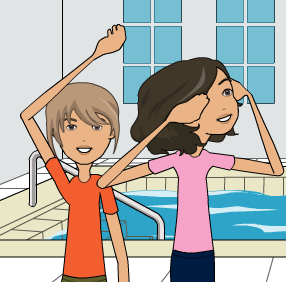
♦Hidden talents cheeky techniques! – and some diving aids
♦Diving techniques – showing ’em
♦Diving stepping stones – the way forward
♦Turning directions from the board. Diving groups?
♦The handstand dives – a special group
♦What are the body positions? – turning faster or slower in the air
♦FINA Degree-of-difficulty– the value given to each dive
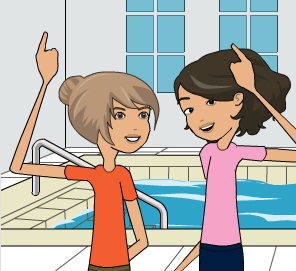
♦How you can score higher than – your cleverer opponent! Ah…
♦The dive numbers – a language to understand whichever country
♦The diving officials – who are they?
♦The recorders & dive sheets – they calculate you are the winner!
♦Competition structure hurdling towards the heights!
♦Synchronised diving – a spectacular event to thrill
♦Cliff diving. A few more steps to climb!
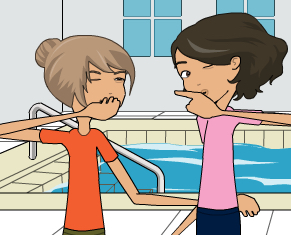
Sport of diving and to learn about diving ‘So Dive in’ was first written 1990 as a little book as an introduction for both children and their parents. It was accepted by the Amateur Swimming Association and used for the “World Start Programme” at the time , for children assessed and accepted to train showing great promise for one day to represent the country. Revised now to online format.
The above chapters/posts it will give you an over view of our favourite sport. They explain the judging system and the scoring system, plus who are responsible for the competitive angle of the sport.
A few progressions are talked about re both in your build up and into, and through the competition levels.
I hope when you sit comfortably at home and watch the top divers of the world performing the intricate movements from the boards and into their “rip” entries this little insight will help you understand the “ins and outs more.” Learn diving!
‘Lani and Celie took their Mum to the diving pool
Mum thought they were acting so cool
Cause they always said they wanted to dive
and for that,their Mum was filled with pride.
Lani and Celie looked across to the very high board,
From which they watched divers that flew and soared.
They watched bounciest boards pressed down and up,
Watched boys and girls, with perfect run up
Flying forwards, backwards… whichever which way,
Showing different turns and shapes… come what may
Sliding into the water without a single splash
Oh goodness me they gasped “what panache”
The girls so wanted to join in all the fun
To join a club simply had to be done
Soon Lani and Celie will become part of a diving club
To acquire new friends and skills within this hub
Who knows they might become champs one day
One thing is for sure, they’ll find a way!’
Sport of diving was written for Children and their Parents?
Good diving decision
Written for children, diving is a wonderful sport. Described in a unique way. Written to include parents gives an over all introduction which is lighthearted and amusing. This basic guide talks about diving progressions, who’s who, how how, and the steps towards the development of a young (or adult) diver whether for fun or with gold medals in mind!
Plunge into learning about this fascinating sport. There are also some of my own personal diving tips and experiences when setting up a club.
Diving is a wonderful satisfying refreshing sport. Nurturing the novice child in the correct way brings fun and achievement – you just can’t go wrong!
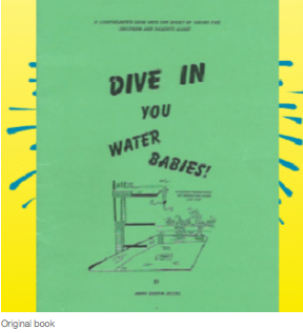
UP
What is Diving?
What is Diving? Spacial awareness with style – that’s diving!

What is Diving ? Spacial awareness with a mix of strength, stamina, with gymnastic ability, synchronisation, acrobatics and trampolining all rolled into one – but… in the air! that’s diving!
A good diver makes every dive look easy. A diver offers grace and beauty that goes with spacial awareness and the aesthetic qualities. Nothing can beat the joy on the face of a child or adult when they accomplish a new dive, jump or exercise.
Everyone has a place within the sport of springboard diving and platform diving.
Whether in the sport of diving for pure enjoyment and challenge, or for aspiring to become a champion, either has a place for them!
A diver may even one day want to give back everything they’ve learned by teaching, training and judging others!
Whichever way, a diver will find fulfilment and satisfaction in the sport of SPRINGBOARD and PLATFORM DIVING.
So dive up from the one metre springboard to the ten metre highboard into that RIP entry!
There are further challenges up and beyond!
UP
Sport of Diving. So you want to Dive?
Good decision
So you want to Dive? Learning to dive means gaining many skills and self achievement. This is a message for children or learner adults – any age! It’s good fun whether you choose learning to dive to take part in competitions for your club, or even your country with the bits in between! or whether you choose to learn diving for pure enjoyment or fun. Either way what better challenging; amazing healthy past time can you choose?
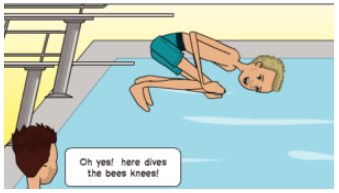
It a lovely feeling to spin; turn and twist in the air. You poise yourself wondering whether you will have the balance when you reach the end of the diving board; and the courage to lift yourself high waiting for either a floating graceful feeling down to the water; or a sudden explosion of energy into lots of twist and somersaults in the air – “ Gosh, will I get all of it in before I reach the water?” you ask yourself.

What about those entries into the water? It’s a wonderful feeling of pulling all your muscles as tight as tight as can be, squeezing your ears with the tops of your arms and feeling yourself sucking the water down with you as you go down into the water from a highboard. All the people above the water will see nothing but a few bubbles as your beautifully pointed feet disappear under the water. This is called “RIPPING” your entries.
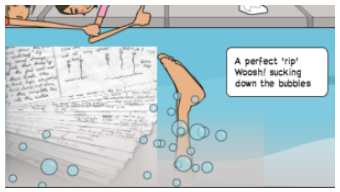
Learning to dive includes “ripping ” the entries. This means sucking the splash down with you, instead of it whooshing up above the water. This is very skilled and very artistic, and electrifying for the audience. Your coach will spend many an hour teaching you this “just perfectly” to score very high points. Below is Ben who is trying very hard! It takes lots of practise.
There are other kind of entries into the water? Water looks so blue, soft and inviting, but…sometimes you can get muddled in the air, completely lose your train of thought, and OUCH! That same water is brutally hard, winding you, stinging your body, and it hurts all over. My oh my! Just look at those bruises emerging over your skin any shade of blue, purple, green or yellow!
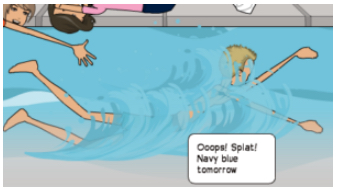
It’s no laughing matter of course but it will make you hero diver of the week when you attend school next day. What better title could be given to springboard diving children!
This can happen when you want to run before you can walk! Understandably you are enthusiastic and ambitious. Another reason is that you are tired and lose your concentration. Your focus can easily be upset when you are thinking of too many things at once or too soon.
It is important children that you progress slowly, step by step over a longer period. For you to be sensible and not attend lessons when you are unwell. You are not sharp and fast thinking when a bit out of sorts.
Talking about being alert and sharp, there are dangers to be aware of in the pool and around the diving boards. Alway listen carefully to your coach;
♦ never push anyone from the boards;
♦ be the only one on the board;
♦ always jump in line with the board and never to the side,
♦ and be sure never to swim under the diving boards.
It is advisable not to attempt new exercises unless your coach is with you, or perform any movement from the board with your back to the water. Dive safely to be safe! And you will be looked up to and others will learn from your fine examples. Parents will be proud of you – you are their diving her!
You will achieve more at a faster rate if you have “Style” and a “Look at me” attitude. If you carry yourself well – that is – have a straight back; pulled in tummy; good square shoulders; your diving exercises will come a little easier to you. Don’t worry if you don’t consider yourself as having good deportment?… that is…walking like a model when showing off clothes – your diving exercises will teach you to carry yourself well. Editing in progress
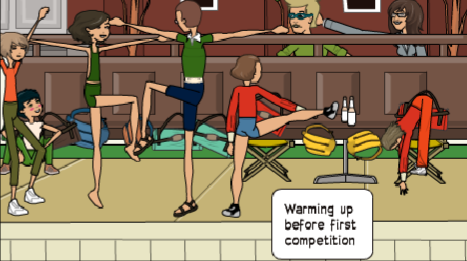
Points to know when learning to dive. If you are aware of what your body does when you move around and have natural ability to stretch your muscles and point your feet and toes you’re half way there! Can you tell if your legs are together or apart? All these qualities will help you balance well on the board, look beautiful in the air all the way right down to your famous “rip” into the water.
To be able to FEEL your body movements controlled, to FEEL whether your muscles are tight or slack. You are then well on the way to learning very quickly.
Don’t fret if you cannot feel as good as this, you will become a very good diver by practising all the exercises streamlined to help you on the way.
All these points mentioned become as effortless as breathing or if you are older enough…driving a car! It does involve a lot of hard work if you are going to take this diving business seriously. Like anything else though, if you enjoy anything, you don’t notice the hard work do you?!
UP
Sport of Diving. Joining a Club
Coach MG Rules the Roost!
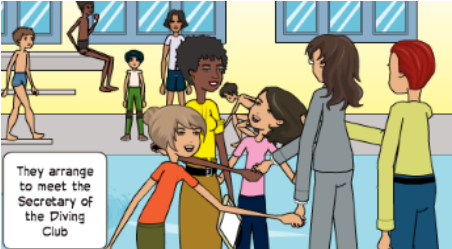
Joining a club and finding one is the first task! Your parents and yourself will be able to find out where the local diving classes take place – either from the swimming pool, library, newspapers or word of mouth. Perhaps you already know of someone already taking lessons?
It’s very good fun when joining a club. You’ll be one of a group of children who have probably been attending the diving club a little longer. First steps will be for you to be grouped in a class equal to your ability.
You’ll be assessed. The coaches will decide how best to start you off. Don’t worry about this assessment. It’ll be fun and you’ll enjoy the sessions. It’s your chance to show off some of your antics during a relaxing atmosphere!
There are many poolside exercises, which should be practised over and over again. You can obtain just as much fun by staying IN the water as out. Spinning and tumbling and learning particular sensations of a dive in the water rather than in the air. Turning upside down, flipping over, twisting and rolling is all part of the game. At least if you should make a mistake in the water, you can’t go “smack” and cry out “OUCH!”
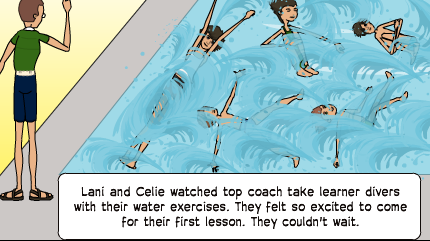
A complete beginner such as yourself, and after a bit of play in the water, in time you’ll be taught various exercises from the side of the pool. You will learn how to jump into the water safely in all directions…forwards, backwards, and even sideways!
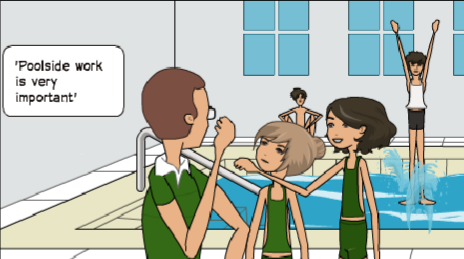
From these simple exercises your coach will be able to assess how keen and how far you’ll go in the diving world.
Everyone can be a good diver – some will reach higher competition levels than others. It’ll be what is personal achievement for YOU Bear in mind also that your co little divers learn at different paces. Some start off slowly but still become excellent in the end, others learn quickly. It will take many sessions to build up confidence and show your friends and family how far you to go!
During lessons you’ll be taught to stretch and get all your muscles working. At first you may feel a little stiff the next day, but the more your muscles get used to it they will become kinder to you!
You’ll become aware of different body positions. Whether you can feel if your legs are together or open, whether your ankles are stretched with toes pointed, and you’ll be taught to use your eyes otherwise known as SPOTTING. All this will help your coach know what to expect of you in the future and give you a taste of the exciting challenges ahead!
Of course you’ll be wondering when your next steps towards success will be starting to jump and dive from the diving boards? Naturally you are very eager, and maybe you will be allowed to jump from various heights of the diving boards. There will be a few “dares.” But…patience is very important at this time, and for your coach. These exercises though great fun and simple will be forming the base of future good diving.
They provide a firm foundation to the variety of dives you’ll eventually be learning – but not until the time is right. Just imagine what would happen if the foundations of your house weren’t built firm and solid? – it would fall down! That’s why exercises are so important in your diving steps.
There will be certain tests, certificates and badges for you to strive for at the same time measuring your diving steps progress. If you are of competitive spirit you’ll be aiming to be better than anyone else…but remember all the others will be trying to be better than you!
Eventually, depending upon your drive and ambitions, you’ll find that you may become individually taught or become part of a “squad”, to eventually to be trained and coached. Coaches look for someone just like you and you could be just the right person the coach has been waiting for!
Attitudes sometimes play greater importance in your diving steps than actual ability. Your attitude is the manner in which you approach your diving training. If you haven’t the ability at first, this can be taught, but to change someone’s attitude is far harder. Within your dreams of aspirations you’ve got to WANT to do it.
UP
Sport of Diving. Mum and Dads Role
How can they help?
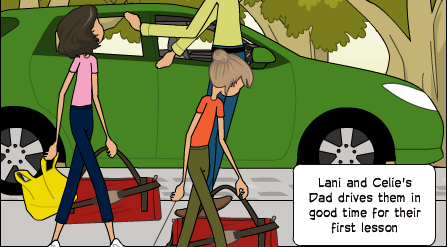
Mum and Dads role is to give you diving support, or other close relation. It’s particularly important when the child starts to attend classes. It’s good for both the children and parents to know about the why’s and wherefore’s of the sport – that is the diving contents knowledge base.
Mum and Dad’s understanding of springboard and high board diving is very helpful in order to support their children. This will help with ambitions and goals. Driving or accompanying them here there and everywhere from dawn to dusk.
Encouraging their children “just by being there.” Watching them from the spectators gallery sometimes is just enough. Poolside parents will be better for it, having insight into the sport. As well as sharing the excitement, diving is tremendously satisfying. They can “jolly” their children along! also encourage them with any diving “homework” they need to practise. And there is always an arm to go round when things are not going right.
Mum and Dad’s diving support can attract participating involvement! There are multiple choices for this. Either on poolside aiding and learning how to teach; record; or acting as chaperones; maybe even sit in an officials chair!
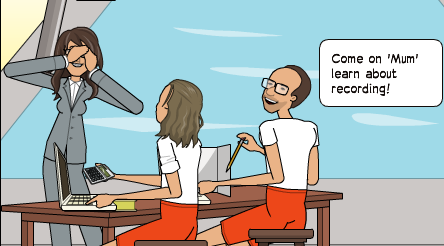
Mum and Dad’s poolside diving support can be in many other ways can help. On the social side, help is always needed to organise the very important events to raise funds. All this, and securing sponsorship gives the “diving centre roll.”
This funding will be towards the best facilities and equipment. Good social functioning within a club is very necessary…and fun. Children will be coached to the highest degree. There are many coaches, officials and members that exercise their specialist roles. Normally on a voluntary basis. Many avenues are to be explored and many positions to fill, balcony, committee, poolside, and home.
Nothing can be more satisfying for parents understanding about springboard diving. They watch their small child starting as a complete beginner. Later graduating through the levels and feeling much pride. It’s thrilling to experience their little ones increase technical programmes. Graduating towards the more intricate and complex dives is exciting. The sport just like any other requires dedication, passion and TIME.
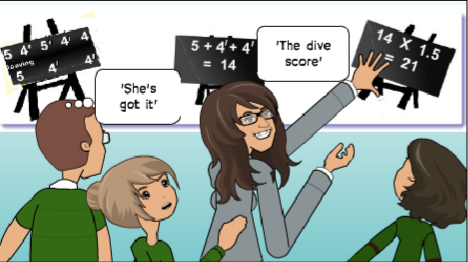
Either it be for recreation or competition heights, diving builds character and discipline. The sport results in much accomplishment and experiences especially for poolside helpers!
UP
Sport of Diving. Your Diving Coach
You wouldn’t manage without!
Your Diving coach and yourself will form a very diving special relationship if you have dreams of representing your club or indeed becoming a top competition diver.
Whether for pure recreation or achieving your dreams, they will come true when the two of you develop a particular diving “language.” This communication will be unique, and only applicable to you and your diving coach. It will take time to develop this important diving communication.
If there is a problem and the explanation is unclear, don’t be afraid to tell your coach.
If it still remains unclear, then say so again and again and again. Your diving coach will eventually find an acceptable way of helping you work the problem out.
Many weeks are spent learning each others needs which are necessary to produce good diving results. Remember! you are as new to your coach as your coach is to you! You’ll get to know each others ways and you’ll become a “team.”
According to your abilities, your coach will place you with children that are of the same talent as yourself. This is preferred rather than the same age group.
Some children of a certain age group can be of completely different standards. Like us all some can learn fast and some take a little more time and the latter… quite possibly overtakes the high flyers in the long run!
Your diving coach is not only your teacher but becomes your friend. Always at your side to support, guide and advise. Your coach will be with you on your good days and on your bad days. You can guarantee that you will receive all the encouragement and attention you need.
Well then, after this basic introduction, are you still keen to have a go?

UP
Sport of Diving. About the Diving Boards
Springboard or highboard ? – the way up!
About the Diving Boards. Diving springboard or highboard (platform) follows on from having learned a little about poolside work. After spinning and tumbling in the water, your coach will ask you to “have a go” from the diving boards. Competition diving is practised on both springboard highboard (or a firm board). The first stop in your diving equipment. Let’s talk about these two different types of diving board.
Springboard
The springboard is simply a board that bends. By being taught the correct approach to land onto the end of the board, you’ll feel as if you are bouncing right up to the ceiling, or up into the clouds before landing into the water! A springboard must measure one metre from the tip of the the board down to the surface of the water when the board is at rest. There is also one three times as high – three metres. They are diving wise called a…
1M Springboard and a 3M Springboard.
In the olden days when diving began, springboards used to made out of wood. They were covered with a material called “coconut matting”. This was to prevent the diver from slipping. (Another must in the diving equipment). Difficult dives today would be very difficult to achieve on these older wooden type springboards. The reason being they couldn’t bend well enough to whip the diver high into the air in order to give enough time to perform many of the somersaults and twists introduced into performances of today. Even today you may still come across one of these relics of the past affectionately known as old planks!
Today, diving has become more technical, and the springboards developed over time to cope with the complex dives of today. They evolved in stages and diving equipment included boards made out of metal, followed by fibre glass. More complicated dives were mastered from these better and bendier boards. The boards were designed in lighter materials and the best one today is called a “cheeseboard”. So called because of the oblong holes covering the hurdling distance into the take off end of the board.
With these holes the board is made less resistant to the air, and thus much whippier and springier to use. It’s a strange experience spotting the water through the board as you approach it’s last section! but if you haven’t been used to any other type of board in your use of diving equipment you wouldn’t know and feel the difference. All the new pools have these wonderful “cheeseboards.
The bendy movement on them is adjustable. According to your body weight, and the strength stored in your legs as you push the board down, it’s flexibility can be adjusted by turning a wheel situated at the side of the board. This rolls backwards and forwards along it’s housing. It is called a fulcrum.
I wonder what we’ll be calling these boards in thirty years time when technology has overtaken us again. NOT old planks surely?!
The Firm Board (or Platform)
The other type of board is the firm board. it is exactly what it’s name states. It does not bend. Diving from these boards is known as Platform Diving or Tower Diving. The boards are set at competition heights of five metres, seven and a half metres and ten metres (nearly 33 feet high). They are called a…
5M platform; 7.5M; platform and a 10M platform.
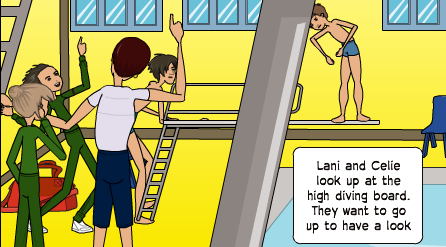
Apart from having to learn a completely new style of take off strength and stamina must play an important part in your make up. Not only diving from the high boards is beautiful, artistic and pleasingly spectacular from such heights, just think about how many times you’d have to climb up the steps to get up to the high diving boards in one training session! Some countries have actual lift towers to carry the divers up to the 10m platform. Weary legs are not one of their symptoms!
Your shoulders, neck, back, arms and wrists have to be strong too. You are entering the water at 34 miles per hour. Your high board training would cover many strengthening exercises to support this. You may notice that some divers wear strengthening wrist guards to protect them from the rigorous entries into the water. But….it all comes as part of the game, and with the correct gradual build up in training you will take it in your stride and shouldn’t suffer discomfort.
So what is it to be? Springboard highboard? A lot of divers use both boards in competition, but normally favour one or the other for topmost competition. I wonder which one Lani and Celie will choose!
UP
Sport of Diving. Hidden Talents
…with cheeky entry saves plus extra diving aids
Hidden talents, extra diving aids and exercise programmes will help with your learning and gear you up to getting the most points possible on your dives. Your entries into the water are the last part of the dive that a judge and spectator sees. They may not be as clean (or splash free) as your coach may want . There will be questions as to why.
Some pools may have an underground passage that runs around the diving pool. Underwater techniques can then be watched. Your coach may pop down there and assess you as you enter the water. On many occasions the problem is spotted and suddenly coach has the answer those splashy entries.
If you are VERY clever… and have hidden talents, you may have been taught an underwater technique that could fool the judges? (even your coach!) If you feel your body is going out of control as you enter the water – either by going over, or flatter (short), you could “save your entry.
Over rotating
Under rotating
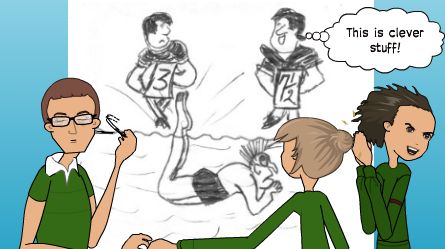
This happens under the water and out of sight to make it appear your stretched legs and feet are vertical as they pass through the water! This is clever stuff! Until you become a skilled diver however, and had your coach train you on saving techniques, for these faulty movements in the air, you won’t be able to pull a fast one on the judges! Your efforts could mess up the dive more so!
Your coach and yourself will know that it’s much better to spend time on your take off. You will be guaranteed control in the air and on your entries. This will prevent having to “save” your dives. This way you’ll become more consistent …and… more honest! However, just occasionally there may be a blip, and quick thinking could add another point onto the judges score.
Your coach may be one who enjoys using other diving aids to teach new dives and exercises. For example, books, videos, films, photographs, posters, talks, live demonstrations, even springboards into sand pits (haha once upon a time).
Nowadays pools have a large screen video recorder constantly switched on to record a whole training session. The screen is normally situated at the side of the diving boards. This enables you to watch your performance a minute after you’ve dived it. Together with your coach’s instructions this helps you to perfect the dive even further.
The Dry Dive Gym
Ropes and Pulleys in the DIVE GYM is next! A huge one in the diving aids category!
The new pools built today, having a diving pool, will have a dry diving gym. This is marvellous and you can learn your new dives, perfect your take off and never get wet and cold! These gyms have a host of equipment from landing mats of all depths, springboards, bars, mirrors, vaulting apparatus and of course the spring of a floor!
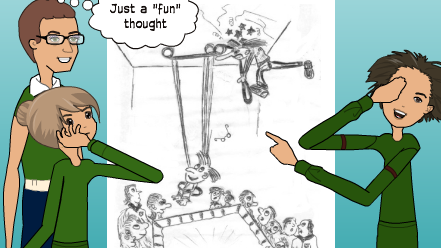
The centre pieces within the dive gym are the trampolines. They have overhead pulleys and hoisting straps. You would be strapped into special belts. This then would enable you to carry on learning the complex twists and somersaults… to the coach’s delight too! As well as the serious aspect, it’s also good fun enabling many chances to be inventive.
Safely secured into the harness you would learn the exact spotting and timing, to begin stretching out from your diving shape to land a perfectly safe and comfortable entry into the water. A very experienced coach has to be in charge. Taking the weight and load of your body on the end of the ropes is a very responsible job.
As a whole you will learn at a faster pace than just poolside exercises, diving boards and water! Occasionally this gear is rigged up over the actual diving pool water.
You’ll learn new dives and your coach will take you through your paces at your own individual rate. You may not be aware of the hidden talents you have. There may not however be access to these fantastic facilities. This won’t matter and your coach will decide on programmes of poolside and diving board exercises. The results, after careful planning and patience will be just the same.
In these fantastic diving pools you will find more diving aids to help with your training. There will come the time that you move from the dry gym and “you have to have a go for THAT new dive for the first time into the water. ” Oh dear, what if I go wrong?” you ask yourself. “What if I hit the water at the wrong time in my dive?” whilst imagining the stinging and the bruising.
There is always an element of daring the first time you perform a different dive – especially if it involves extra somersaults with twists. To help you overcome these fears there is apparatus in the diving pool called a “bubble machine.”
When your coach counts you off the board, coach presses a switch on a hand set and guess what? a load of bubbles begin to rise up to the surface of the water from the pool floor. They continue rising up and above the water forming an air packed mound. (It’s better than any wave machine!) This mound will cushion your entry into the water if you make a mistake and it won’t hurt. Mind you…you have to go on the count of three – otherwise you’ll miss those vital bubbles.Before the machine was invented it was a practise to make a bubble wrap jacket out of your parents parcel packaging. Seriously! With all these supportive diving aids it won’t be long before your hidden talents emerge!
UP
Sport of Diving. Diving Techniques
On the way to scoring Springboard success
Diving techniques start by demonstrating your skills to the judges and all those people in the gallery!
Competitions and tests make diving all the more exciting. You may not be a competitive person however, and may just like to dive for the pure enjoyment and self satisfaction. I must hasten to add that even when competitive it must be for the same reasons!
Diving techniques include turning your body in all directions in the air, plus showing different shapes. It’s a marvellous sense of achievement when you begin to turn your body all the way round in the air to perform one somersault or one twist. Then gradually add another half somersault or half twist, but…more about this later.
Springboard diving is very satisfying when you accomplish these more complex movements, If you are a person that would enjoy diving in competitions, remember above all, you’ll be diving against yourself. It doesn’t matter who you are diving against. If you beat your own personal best points then you’re making tremendous progress.
Remember these diving techniques. If you put a brand new dive into a competition recently learned there may be the risking of a few points by taking the gamble, but just think…in the future when the others have to get around to taking their gamble you’ll be nailing your new dive perfectly!
When you take part in competitions, the judges are looking at your diving techniques. The way you stand, how you carry yourself to the end of the board when performing a hurdle step dive (running dive). They will take note if your feet land together on the end of the board and that you don’t hop off.
They will take into account whether you’re leaning too far backwards or too far forwards, followed by the height you achieve in the air. The shape of your body will be studied – to make sure it conforms to the dive announced. Finally they look how you enter the water. They will want a clean near vertical entry and when you are more advanced they’ll see how you “rip” your entries by sucking the water down as you pass through. The judges in an instant puts all these parts together, seeing the dive as a “whole” then immediately awards the points.
Judges indeed have to be very sharp because the dive is over in a flash. Depending upon the level of the competition will depend upon how many dives and in how many different directions you have to do.
Usually there are five judges that award 10 points for the perfect dive. Sometimes there will be seven judges. Before you reach this standard you’d be a world class diver.
Normally for every part of the dive that don’t fulfil expectations there are certain numbers of points that are rapidly subtracted. Sometimes a judge can award you zero points. This does seem a little harsh but if they consider the dive you performed was not the dive announced, then it becomes a failed dive.
An example of this is if you by this time were an advanced diver and performed a dive with a number of twists – you may spin round too quickly and not “check” out at the right time. You may go over the required twists by a quarter or half a twist by mistake. This then would not have been the dive that was announced would it? It might have been very clever but it didn’t conform! Thus it will be a failed.
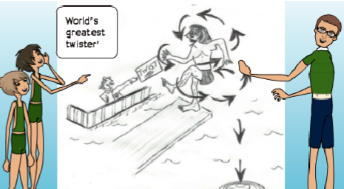
Similarly if you perform half a somersault more than you should have it will be …FAILED. There are many other instances in the rules that can also offer this penalisation. It will be up to the head judge of the competition – the Referee
UP
Sport of Diving. Scoring System
Diving techniques and points banding that the
judges award you …
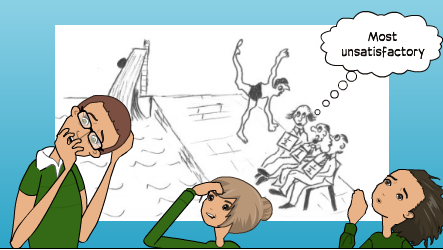
0.5 – 2 points if the dive was unsatisfactory
2.5 – 4.5 points if the dive was deficient
5 – 6 points if it was satisfactory
6.5 – 8 points if it was good
8.5 – 10 points if it was very good.
8.5 points and over would be an extremely high standard of diving, and to achieve the perfect 10 from all the judges you’d be on the way to becoming world class and an Olympic Champion.
If first you may find that you are scoring anything up to 4 points. This is normal and to be expected. As time goes by, your diving techniques with your determination will be improving, and your scores will be increasing. NB in minor and beginner competions, the referee may allow the judges to “up” their marks in order to give encouragement.
With practise not only will your dives be improving, but your competition experience will be your way of life. It’s frustrating knowing how well you normally perform your dives for them to not “go right” in the contest. It’s just one of those things. You have a bad day at the office. You grit your teeth and just carry on. Your rivals, the other competitors very likely will be having the same problems.
With time your experience grows, so will your consistency. Your coach will be aiming for you to dive throughout a competition with steadiness. Even if your scores remain around 4.5 points you could still win a competition this way. Rather than dive a fabulous one worth 7 points from the judges and then dropping your next dive down to 3.5 points it is better to maintain a certain level, rather than see-saw along your competition dives.
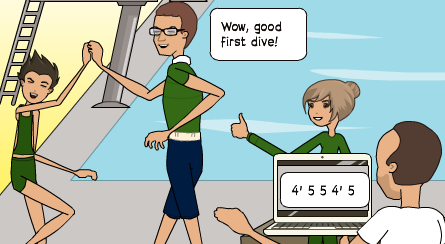
It’s all good fun and over a period of time your steady points will be moving higher and higher up the ladder. 6.5 points average on a set of dives throughout a contest will be the start of realising your dreams. You should soon be in contention for winning a national title one day and even representing your country. Your coach (and parents) will be beckoning you to the top!
World class divers can make blips too!
World class divers can sometimes make mistakes in very important events. Whilst sitting in the comfort of your armchair it’s not uncommon to witness a splat on television. Generally they are aiming for exactly the same steadiness as you throughout their competitions. You must remember however they will be performing very complex movements in the air comprising of multi somersaults combined with twists. But the feelings are just the same as yours when they go wrong.
Being on top of the world is sure the greatest achievement in your diving progress.
Divers of this calibre are expecting to score between 8-10 points on their dives. When diving amongst the best in the world, the motto is one you’ve probably heard many times before…
‘If you don’t succeed, then try try and try again!’… It’ll happen.
UP
Sport of Diving. Stepping stones
…through Diving Competition

Stepping stones through Diving competiton will be assessed by your coach all the way! You may start with “tasters”. These will be in very basic contests just suited to you! It will include jumps in the forward and backward directions with different shapes of your body. More on this to come. The object here is to learn and show how you can control and stretch all the parts of your body from taking off and entering the water.
Coupled with little contests are grades, tests and certificates. Exercises will be provided for you to practise – either in a dry gym or from the poolside. You may even use the lowest springboard in your pool. You might even be ready to jump from the higher boards, learning how to ‘line up’ your body for entering the water.
Next stage
The next stage could be that the competition may include jumps and dives from the low boards and gradually move higher. The club that you attend may split the children into age-groups in order for children to dive against those in the same age band. These are usually 8-10 years; 11 – 13 years; 14 – 15 years; 16 -17 years; and seniors. Some clubs may have a competition for very young divers – under 8 years.
From the very beginning of starting your stepping stones, there are constructive fun competitions for the very young divers, exploring what they can do. There are many clubs that hold “meets” where you are diving against those representing other clubs . “An Inter-Club Competition” This is when you start to make new friends in the diving world, and will always be on the scene whatever stage you achieve.
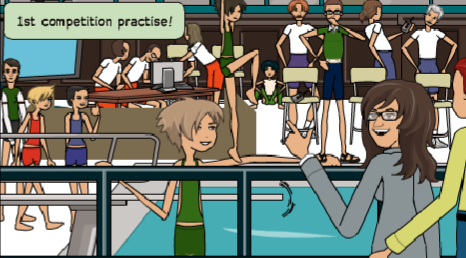
Very often you are going to be diving against these same divers in regional and national competition. It’s an opportunity to keep up to date with what they are doing! It’s not all hard work, there are many parties to enjoy and arranged outings, and you make many longstanding friends. You may be rivals but you can also be great pals. After all you are all in this sport of diving together.
picture here
As you improve and learn more, your stepping stones to diving competitions becomes more varied. Whether you are diving at club level; regional level; or national level the competition requirements are kept much the same. This naturally helps build a good basic programme for training. Also although competitions take place all the years round, you may have some clumped over a short time period. It’s nice to know that whilst you are training for one competition it will cover the requirements for your next one!

So you’ve tackled all this…and now…. we go to competition structure and …the sky’s the limit!
UP
Turning Directions
The Groups of Dives
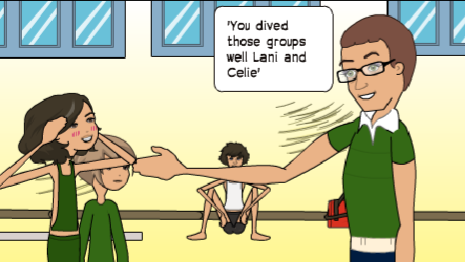
Turning directions are the way you travel through the air once you have left the diving board. These directions are otherwise known as the Diving Groups. When you start from your feet and end up on your head…you turn!
The purpose of the “grouping” is mainly that large numbers of somersaulting and twisting dives (turning dives) can be practised from any of five directions mentioned below. Without the grouping system it could be headache for the recorder. Divers need to hand in dive sheets to the recorders with their dives recorded before a competition. The recorders have to be check and sign them all. Diving “whichever which way” would be quite haphazard! There would be no synchronisation in the presented dive sheets. Imagine the number of divers that would be diving and the number of dive sheets!
Separating the turning directions into groups not only makes competition organising much easier, it also helps with the setting of performance rules and regulations for the particular standard of the competition. For example – so many dives must be performed from so many groups. So divers must stick to the set rules when training for the particular competition.
Diving groups instantly point out whether a dive is turning from the board in the following directions…
Forwards – Group 1
You stand on the board facing the water and leave the board turning forwards until you enter the water.
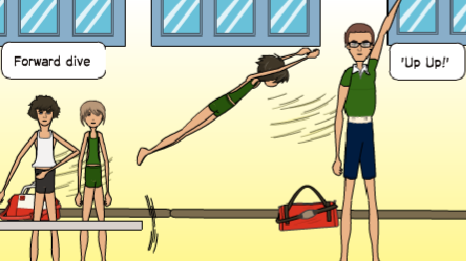
Backwards – Group 2
You stand on the end of the board with your back facing the water, You leave the board and with your eyes, follow the wall and ceiling round.
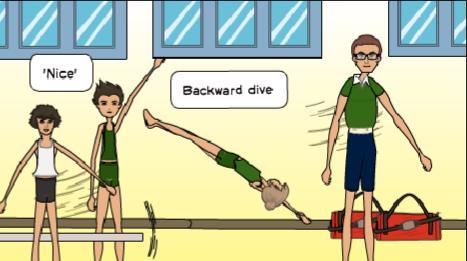
Reverse – Group 3
You stand facing the water but on leaving the board you turn backwards!
A reverse dive is a very strange direction. Associated with the backwards direction there is a little more! Think of a car driving forwards into a garage then changing gear to drive backwards out again. The car will be reversing Don’t worry about this dive. It’s a lovely sensation.
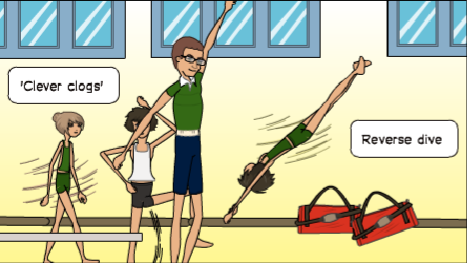
Inwards – Group 4
You stand on the end of the board with your back facing the water but you turn forwards!
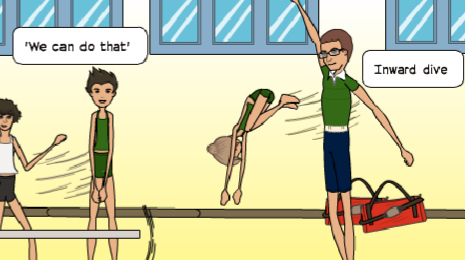
Half turns means the same as half somersaults
In all the above directions, your coach will teach you the basic half turn. That is – you leave the board with your feet and turn headfirst into the water – a half turn. As you progress your coach will help you add another half turn on top! This will make a full turn, or one somersault. Another half turn on top of that and it will make three half turns or one and a half somersaults. A number of half turns can be added, and the world class divers of today manage 8 half turns which make four somersaults! From now on we will refer to turns as somersaults .
Twist – Group 5
We now come to a direction that turns like a spinning top (or log roll). The twist group.
You can use this twisting action with dives performed in all the above groups. You begin to learn how to roll like a log rather than bunching up and forward gamboling.
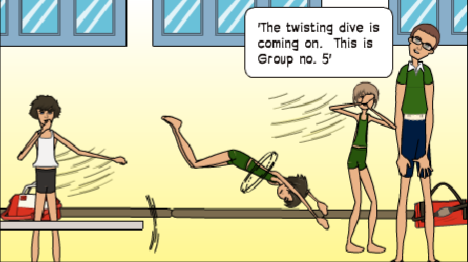
Imagine someone rolling you in a carpet. Coach will start you with half a twist and as you become more proficient you’ll be adding more half twists into your dive. When you become very talented your coach will start asking you to twist and somersault at the same time!

Remember the lovely dry gym equipment? Would you like to be strapped into the harness and learn your somersaulting and your twisting. (Previously mentioned). At this stage you’ll be emerging as a very advanced diver during your learning curve, and certainly someone to watch.
General somersaulting progress
As you becoming more proficient at taking off from the springboard, your coach will then add more half somersaults to your dive… until your capacity, skill, and stamina in the air is exhausted!
Your coach will guide you through the gradual progressive exercises towards these more difficult dives. Step by step you’ll build your repertoire within this group of dives. Soon you’ll be showing and feeling the confidence to tackle dives with two and a half somersaults plus! remember always, that to learn well is to be patient. Your coach will not allow you to attempt any dive unless the correct foundations are SOLID
Diving groups become part of the number coding which helped develop a universal language for any Nationality to recognise in an instant which dive the diver is to perform. Essential for international officials and…security for the diver knowing which dive the judges are expecting to award their points. A valuable tool. More about this later.
It’s pretty amazing when somersaulting from all the board heights in the different body shapes. These will be discussed in another section. Whether head first, or feet first entries. Somersaulting by adding halves anything between 2 to 9, my goodness what a thrilling experience… and for your audiences!
Basic Mechanics
You may wonder how these different turning directions affect the positioning of yourself in the air. For example “will any of them bring me closer to the board?” Fear not if you have been working on your consistent take off from the board.
There is a principle to bear in mind here. Once your feet have left the board – any dive, any jump – the action of rising high from the board and back down to the water creates an imaginary path in the shape of an ARC. This is set no matter what you do in the air – forwards, backwards, reverse, somersault, twist, wiggle about, and anything else you can think of – the ARC is formed and nothing can change this. Your ARC of flight is set.
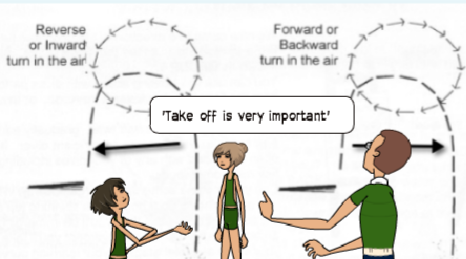
Not finished yet!
Group 6 is the Handstand or Armstand Group. Next…
UP
The Handstand Dives
…otherwise known as Armstand Dives or push ups Group 6
The Handstand Dives or push up, or Armstand dives are dives that are performed just what it says. You take off from your hands!
Handstand/Armstand push up dives provide many challenges. It’s an extra achievement to being able to kick up and hold a steady balance on your hands. The guidance is at least 3 seconds before carrying the dive into its performance. The dive can be carried through either forwards, backwards or reverse direction.
The first Handstand dive you learn is an armstand forwards over. After holding a steady balance you would then just fall over forwards and land in the water either feet first or continue turning for a head first entry into the water – (you would then have completed one somersault!).
***
Armstand cut through (reverse action).
The next step would be to ‘reverse’ the direction- go backwards ?).
Once up into a nice steady arm stand, can you see the legs fall backwards towards the back wall of the board, round, and thread them through his hands! This at first is practised with one half somersault into a feet first entry, then gradually built upon with extra half somersaults.
***
On to more handstand dives.
In recent years a competition dive performed is a Handstand backwards. You walk to the end of the board and turn round to face the wall at the back end of the board.
You bend over forwards and position your hands widespread outside of the feet with the palms of the hands just on the edge of the diving board. You would then gracefully and steadily raise your legs up over the water into a vertical position (a pike lift). After a steady balance of at least 3 seconds your legs and body will fall backwards to land in the water feet first.You’ll be facing the diving boards as he enters the water. Another half somersault may be added, gradually building up with more This is in fact an backwards action from the hands.
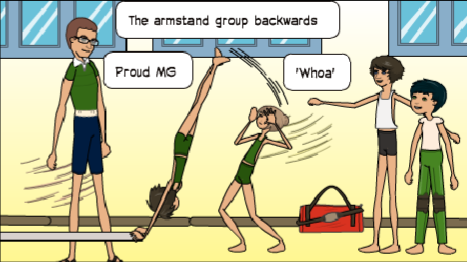
Divers spend hours and hours in the dry gym practising their handstand push up balances. Against the wall; away from the wall; rotating forwards; cutting through (reversing) and rotating backwards. From the floor they move to a low platform to practise and land backwards onto very deep mattresses. They then graduate the “moves” from the poolside into the water then up onto the lower boards moving up to the highest board.
NB. Handstand push up dives otherwise known as Armstand are only performed from the firm board (platform).
It is remarkable to watch advanced divers practising multiple somersaults – forwards, backwards and reverse from their hands. It’s in the gym that they practice a whip of their lower legs to get the acceleration they need for turning, when performing multi somersaults.
UP
What are the body positions
…during flight through the air
Body positions can be in any of the main three set shapes. You will spot a diver using any of these body positions during their passage through the air. These positions are used for any direction you are turning from the groups already discussed. They are appropriate to the number of somersaults you’re trying to perform during the dive.
The position determine whether you want to spin fast or a little slower. The positioning of your arms legs or head are responsible for this.
Everyone, every object, in fact everything you see on this planet has a “centre of balance” (centre of gravity). Everything that projects away from this centre of balance – in a divers case, arms, legs and even head – alters the way that the body turns. The centre of balance of a human body is an imaginary dot inside your body between your front and your back at the level of your hips. Depending upon your body position, your centre of balance moves outside your body and can be any distance away from your hips. This depends upon how much bend you give your body, and how far away, or near, your arms and legs are placed in distance from your invisible centre of balance. The red ball represents your centre of balance.
The closer your head, arms, legs and chest are from your centre of balance the faster you will turn. The further away you take them then you will turn more slowly. This is all according to the diving body positions you wish to use. Basic illustrations below.
Straight or position A
This means that your body shape is held perfectly straight with no bend at the hips or knees. Your toes must be pointed with the your in line with the upper part of your body.
how straight a ruler is. This is how your body should be. Your arms may be in any straight position in the air, but as you enter the water the hands are clasped beyond your head. Your palms face upwards and your upper arms squeezing your ears. Your head must be in line.
It is a beautiful position, and looks really graceful during a half somersault (from feet to head first). The “A” position can be performed in the forward, backward, reverse, inward and twist groups.
The straight position is one where you will rotate or turn slowly. Your arms and your legs are far away from your centre of balance.
***
Pike or position B
This means that the only bend in your body is at the hips. The knees must be stretched, with toes pointed and the head in line with the upper part of the body.
Your arms may be in any position. They may be close to the sides of the body, pulling onto the backs of the knees, or stretched down to meet the toes. They can be stretched out sideways across the shoulder. This last position of the arms is called an “open” pike.
Your coach will find the best position for you whether its for the simple pike dive, or a somersault or multiple somersaults. You can apply the centre of balance law here – the closer your arms are pulled in to the centre of balance the faster you will turn and vice versa. So it really depends on how fast or how slow you want to turn where you place your arms! A general thought to have is, that you turn at twice the speed than if your body was in the straight position. This shape is performed in all the diving groups.
***
Tucked or position C
This means your body is bent at the hips and the knees. You pull into a tight ball. Your arms are pulled in to your side, with one hand on each shin (just below the knee) pulling them in tightly. You make yourself as small as you can.
Your toes must be pointed and head should remain in line with the upper trunk looking over the tops of the knees. This position C is used for faster somersaulting dives especially for 3 or 4 somersaults plus. However this is the first position you learn for all basic dives and simpler somersaults.It goes without saying that as everything is pulled in close to your centre of balance you rotate or turn very fast – twice the speed as when in the piked position and four times as fast as when you are in the straight position! This diving shape is performed in all the diving groups
***
The fourth from the body positions is one which isn’t a particular shape at all! This is labelled
“Free” or D position
This body shape or position is literally what it says. Normally any shape to help you fulfil the somersaulting dive with a twist to help you with a good entry into the water.

Normally this is acceptable whilst learning a brand new somersaulting dive with a twisting action at the same time. At first it may look a struggle but….boy….the entry is good! For example you may have started with a piked shape but had to bend your knees to get that good entry. Very usually the dive is soon perfected and the shape evolves into a pike shape all the way! This D position is accepted in all the diving groups.
***
A dive that uses two diving positions is…
A Flying Dive.
This incorporates the straight position held for 180 degrees followed by either a pike or tucked position. This dive can be performed in any direction apart from the twist group.
GIF image.
UP
Sport of Diving. FINA Degree of difficulty
Dive values set in a tariff table
FINA degree of difficulty – Federation Internationale de Nation Amateur, is a group of persons “up top” from around the world who set the rules for our aquatic sports.
Just like the price of your track suit, they set or agree on the “price” for every dive. What it’s worth. Everyone of your dives will have a value. From the time you start learning to dive, right up to the Olympic Games and World Championships, all the dives you learn will have a value.
We have talked about the different turning directions you travel in the air recap at the end of this page…
Remember that your dives are learned and built upon starting with half a somersault. As you progress you will be adding more and more half somersaults in these directions, possibly right up to three and a half somersaults, even four and a half somersaults. Also these dives with any combination of twist, two twists, three twists and four twists! and we mustn’t forget the shape of the dive…recap at the end of this page…
Of course it goes without saying that all these fantastic dives with the extra somersaults and twists become more difficult to learn, let alone master for competition. It’s therefore not surprising that the value of them are higher, and it’s even more not surprising that the value is also known as the ‘degree of difficulty.’
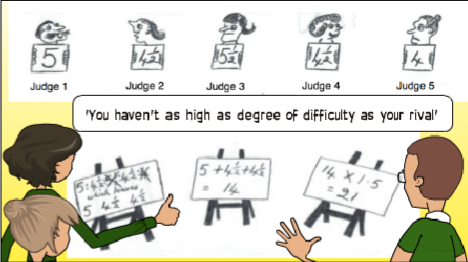
The FINA diving “panel” as mentioned, is a group of people that sit at the top of the sport. This panel makes decisions on the laws of our sport. There are representatives from many countries that take part in discussions. Decisions and regulations are made and this includes the standards for organising competitions.
Officials at varying levels involved in diving competition decide how many dives and from which groups are performed at the varying levels of competition e.g national, international etc. They consider also…divers in age groups e.g. Under 10 years; 11 – 13 years ; 14- 15 years; 16 – 18 years and above etc etc. All competitions must be dived within the FINA set of rules. FINA diving decides how dives are marked, and recorded and for simplicity, the conduct of competitions.
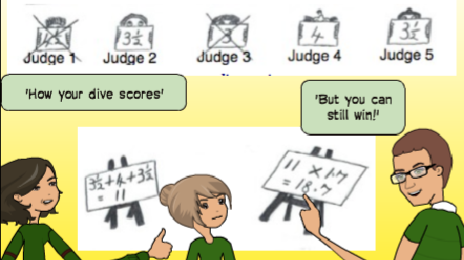
The FINA diving “listed’ dives have an appropriate value (degree of difficulty). It is known as the “Tariff Table”. There are loads of pages of dives which cover the dive number; description; board height; shape (A B C or D). There is a section for springboard and a section for highboard (platform).
Here are snippetts of the FINA tariff Table for Highboard and Springboard
Your diving coach will have one of these in hand. An example is the top picture showing Lani diving a forward dive piked (B shape) from the I metre springboard
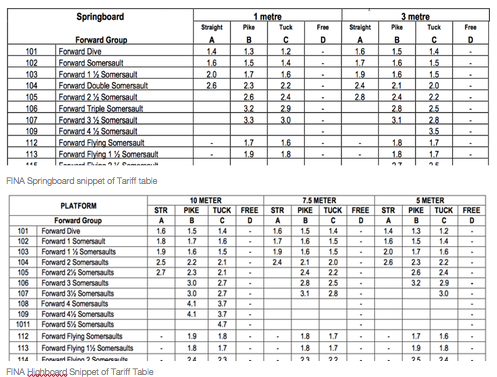
So you see how the dives, your dives are given a “price” The reason being that these values are very important when it comes to your points for a dive in your diving competitions. The dive value “price” is multiplied by the judges score for each of your dives. The top and bottom scores for performance will be knocked up, more about that later.
Divers are invited to create additional dives and work out their dive values. They used to have to perform them in front of the FINA diving ‘panel’. If they were not acceptable they would not be added to the tariff table. However! innovations are now recognised. There is a special formula to work out their unique degree of difficulty.
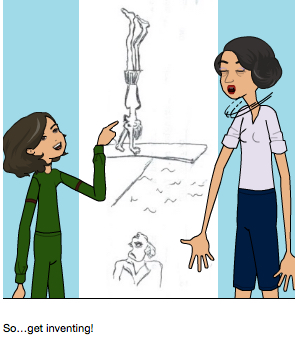 So…get inventing!
So…get inventing!
UP
Sport of Diving. How you can score higher
This demonstrates how the easier dive can win for you!
How you can score higher. Outcome of competition results needn’t worry you. You shouldn’t be concerned that your closest opponent has a more difficult dive on the list…and will beat you? Not necessarily so. You can still win! despite your opponent’s higher degree of difficulty. Just hold yourself together and don’t be concerned that you can’t beat this extra clever diver going for the wow factor!
Your dive
Imagine that you performed a forward single somersault -102B – (B is your shape) from the 1M springboard, the degree of difficulty being 1.5. The judges gave you these points and always the highest and the lowest are knocked off. In this case the 4.5 and 5. The remaining points are added together 5+4.5+4.5 = 14 and multiplied by the degree of difficulty (the dive value) x 1.3. This gives you the final score for your dive 21 points
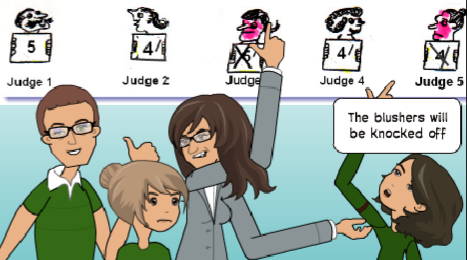
Just something to bear in mind – that if more than one judge gave the same highest or lowest points, one of those each would be knocked off.
Your Opponents Dive
Supposing you’re very confident opponent attempted this more difficult dive by adding an extra half somersault. This would be a one and a half somersault piked – 103B from the 1M springboard, the degree of difficulty being 1.7. Your rival scored these points…
The top and bottom points are knocked off, the remaining marks are added together and then multiplied by the degree of difficulty 1.7 and the final score for the dive is 18.7 points.
So you see – although you went for the easier dive, the outcome of your dive’s points still scored higher than your opponent. But…on the other hand, if your opponent had performed the harder dive WELL, then that is a different matter!…and the sooner you learn it the better!
As mentioned earlier, it’s a little bit of a gamble trying out harder and newer dives in competitions for the first time. This is what makes competition diving so exciting. You never know the competition results until the end of the very last round of dives.
Of course you WILL go on the win the competition! It’s such a milestone in your sporting life when you hold your first trophy. – You’re on the way to grabbing as many as you can.
UP
Sport of Diving. The Dive Numbers
Dive Formula describes elements of a dive. A universal diving language
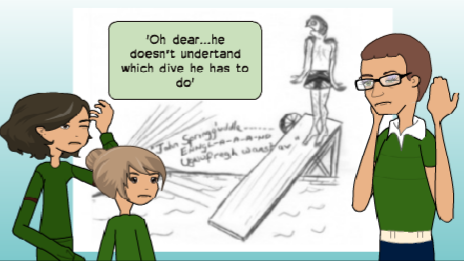
The Dive Numbers are a Dive formula describing the elements of a dive. It’s important, as competitions are held up to world international level. It is a numbering system that describes a dive so that everyone can understand. Dive numbers or dive formula is universal, and one for all!
Reasons
Every dive has a Dive formula -otherwise a number. You’re a fantastic diver now! You’re standing on the board in another country whilst your dive is announced. H-E-L-P! you don’t understand what you are hearing. Is it the correct dive? if it isn’t the correct one and you perform the dive in the competition YOU were expecting to do, the referee will fail the dive. This is where the universal dive numbering or dive formula serves a good purpose.
Remember also that the judges and other officials are of mixed nationality and therefore need to understand and be prepared for the dives they are judging. In the previous sections we talked about the groups (directions turned in the air- see below, you can recap) and the body positions to be used for competition diving (see below and you can recap)
From these groups and body positions, a language has been invented that everyone understands – no matter the language spoken. Using the dive numbers code, either a number board is placed on the poolside, or the dive with the divers name, and number of the dive is projected onto the dive recorders screen. This is projected onto large screens around the diving pool for you and spectators to see. It also adds excitement because the running totals and positions of each diver is screened as the competition progresses. Incidentally the judges also receive the dive number into their handsets.
Once you have mastered how to work out the dive formula or numbers, and what they mean, you’ll feel assured that the dive announced was either correct or incorrect. The judges also will not be left guessing …and they will have split second preparation time to mark the dive when it’s performed.
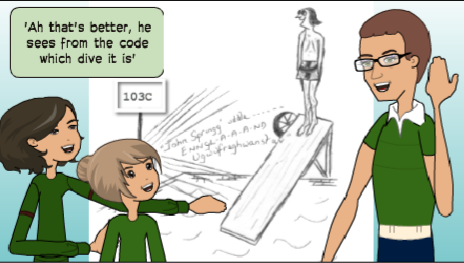
Right…now how is this number 103c worked out?
For translation we have to think of the “diving groups“; the number of “half somersaults” SEE GROUPS SECTION
and the “body positions” A B C D; in order to give the answer. SEE BODY SHAPES SECTION
Thus…
1 represents the group forwards
0 represents non – flying dive
3 represents the number of half somersaults
C represents the body shape – tucked.
The dive number thus is a forward one and a half (1.5) somersault with tuck = 103C
We talked about flying dives with two body shapes. In this case 1 represents “flying” ( holding body position straight for half a somersault before tucking and piking)
If the dive description was a “Flying” 1.5 somersault C then the dive formula or number would be 113C
Test! what are
203C? 302B? 404C? 213B? 101A?
Now let’s go a bit wild
What happens when you are going to perform a dive in the diving competition when it has a twist with somersaulting action in any of the turning directions?
Let’s take from the dive numbers a 5132D?
Group 5 is the twist group. When a dive has a twist, the dive number ALWAYS starts with 5 – instantly recognisable. So…
5 represents the group – twist
1 represents the next group – forwards
3 represents the number of half somersaults – 1.5
2 represents the number of half twists – 1
D represents the shape – free position
Thus the dive is a forward 1.5 somersaults with 1 twist in the free position
Think this way
Remember the two outer numbers are concerned with the twisting part – think of a log rolling.
The two inside numbers are concerned with the turning direction and number of half somersaults – think of gamboling!
Test! can you make out these?
5233D? 5111A?
Here is the 5111A dive.
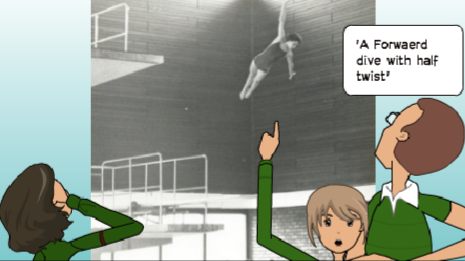
Beautiful and yet very rarely seen these days, is the Half Twist Dive. Possibly because the flight in the air does not provide a basis for building up into a more complex dive. But it does exercise control of the take off from the springboard.
It doesn’t finish here!
What about the Handstand Group – Group 6?
See Handstand/Armstand Section
In Diving competition the code is immediately recognisable that it’s a handstand. The Handstand or Armstand group always start with 6.
The handstand may rotate or turn forwards…or backwards which would then be followed with 1 for forwards, followed by the number of half somersaults or 2 for backwards followed by the number of half somersaults.
The handstand may begin to rotate forwards then move backwards to bring through the arms (cut through). Think again of a car beginning to drive forwards then reversing back into the garage. This in fact is a reverse action therefore the 1 would be then followed by a 3 for reverse followed by the number of half somersaults
The handstand may rotate or turn backwards and continue backwards turning. This is the backward action therefore followed by 2 for backwards followed by the number of half somersaults
Example…612C
6 represents the handstand group
1 represents the forwards group
2 represents 2 half somersaults
C represents the tucked position.
Thus the description of the dive is… A handstand forward somersault with tuck. A reminder of handstands and their directions below.
Note: When announcing piked or tucked dives for the judges during a diving competition, for clearer hearing within an echoey building, piked is “piked”; tucked is “with tuck.”
UP
Sport of Diving. The diving officials
Who’s who and What’s what Hows how – making it all possible
The diving officials are of the utmost importance. There wouldn’t be any diving history if it weren’t for the diving persons running and organising competitions. Judges give you something tangible to measure your progress! Apart from you and the most important person – your other half – your diving coach, who else is important in your diving adventure.
Diving Judges
These are the vital members of the competition team. But without YOU their role will be redundant. However, without THEM you will have no measure of your progress. Judges go through exactly the same channels as you do . They progress through judging levels just as you as a diver. Judges come from regions of the country. When they make the grade at district regional level, it’s not long before they have the opportunity to take their study further. If so inclined can become a national judge. This means that these judges help find the champions of the country!
See “Scoring to Success ” chapter below. The judges award, and the things they look for, and how they could see your dive.
Through reputation and good decisions the national judge can go higher. This is by representing their country and becoming an International judge – like you as a diver! This position is of high accolade. They will be judging divers from all over the world in top diving contests. An example would be the Olympic Games and World Championships.
These judges would have started at club level. Then district, right up to national and international levels. They would have undertaken trial periods. Also placed on probation. During these times trainee judges would be assessed and take written exams.
Where do they come from?
Diving judges have most probably been divers themselves. They want to plough back some of their learning back into the sport. Aspiring diving officials might be diving coaches. Again because of the same reasons of “giving back to the sport”. They could be parents who followed the sport through with their child.
Anyone from a club who expresses a desire to take up diving officiating can become diving officials. It grows on you!
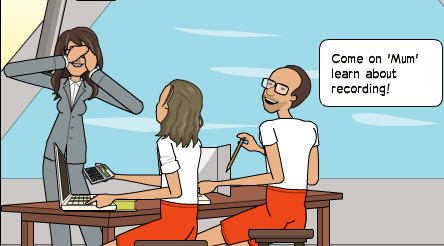
Referee
The referee “presides” over the competition. He or she is the director of the rest of the diving team for that day or competition, the figurehead. In major contests there is a chief referee. This official presides over all the diving events of the day. This is a very responsible job!
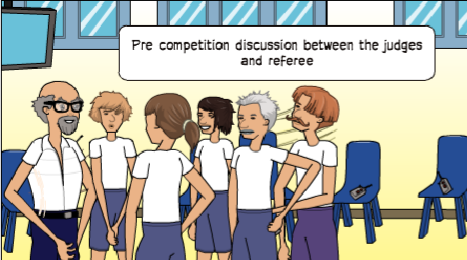
A referee is a judge appointed as the top judge of the competition. The referee has many observations and decisions to make. The referee is seen as blowing the whistle to alert the judges for the start of a divers performance. There are many underlying responsibilities that the spectators don’t see! Just a few of the responsibilities are named here…
The seating of the judges. A referee has the authority to reseat them during a competition. This may be because extraordinary circumstances. A referee signs and checks all dive sheets at the end of a competition. This declares the competition was conducted conforming to ASA law. The referee decides when a dive is failed. The referee advises judges on any penalisation which may occur. The referee settles any disputes during a competition. The referee decides when a diver is allowed a re-dive. The referee will also on occasions double his responsibility and act as a judge at the same time.
A referee has the authority to remove any judge during a competition. For example: A judge may become ill. A judge may miss dives because of fatigue. The referee can also spot bias. The referee has the power to halt a competition. There may be extraneous weather conditions.
Competitions taking place outside can be vulnerable to high winds. Inside pools system failure can occur. The referee ensures that all recordings of the competition until that point are securely filed. This is until such time the competition may resume. The referee can disqualify a diver due to bad behaviour during a competition. The referee calls the judges together to advise various conditions of the contest. A chief referee can appoint a “Jury of Appeal” to assess and settle disputes that occur either or after a competition has taken place.The examples above name just a few of the responsibilities that a referee has.
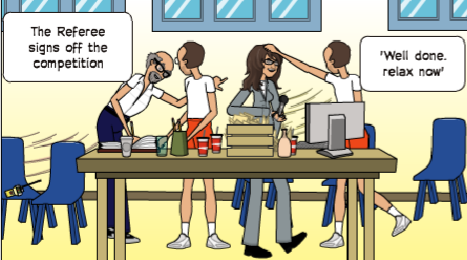
A referee has come from and worked their way through all the levels. If so inclined also towards the same accolades of top internationals. Just as the judge. A referee is selected on the basis of being a very experienced diving judge!
Announcers
In the past the referee had the added responsibility of announcing each diver. and their dive. This would be one after the other throughout a competition. Once the diver
alighted the board the Referee would announce their name and their dive. This was to alert the judges, and also inform the spectators what dive they expected to see. In some instances this may still occur, but nowadays Announcers are “employed” to fill this role. The Announcer sits with the recorders and keeps an eye on the timing. The announcer paces the competition accordingly. When there are queries or a dispute, then the Announcer calls over the Referee.
QUIRKY!
https://youtu.be/I8YKc3ZT6w0
A little round up!
Recorders
The competition team cannot be without the all important recorders. They work out if you have won your diving competition! also having other responsibilities of organising the paperwork involved with competitions. The Recorders will be discussed in the next section.
UP
Sport of Diving. The recorders & dive sheets
Proceedings for entering Competitions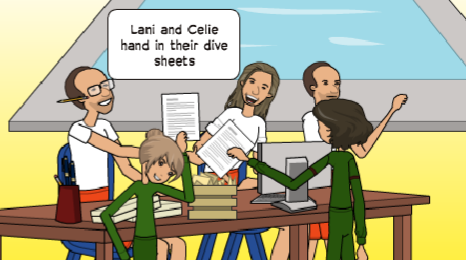
The Dive sheets are filled in by the diver and handed to the recorder to keep a running total of all the points awarded
Diving Recorders as with the other diving officials work their way up from club level, through district level and if inclined becomes a national diving recorder. They undertake tests and assessments at all these levels – the ultimate being an international diving recorder.
For every competition there is a minimum of two diving recorders plus the announcer. They will be working with the referee and of course the judges. The recorders are placed at a table which also accommodates the announcer. The Diving recorder will ask for Dive Sheets to be filled in.
A typical dive sheet to be filled in. There are official ones or club ones. So long as they have all these vital ingredients…
Before every competition the diving recorders have the responsibility to check your dive sheet and all the other competitors in the competition. This is to ensure that your dives and everyone else’s dives match the rules of your competition.
Here is a taster sample of a Degrees of difficulty for springboard – “Tariff Table” This covers every dive by dive number and description, every body shape, every group, every board. See previous sections
They also check that the correct degree of difficulty or value of the dive has been filled in correctly. They make sure you have written the dives in the order you will be performing them. This should meet the competitions requirements. They check also that your dive sheets (and everyone else’s) has been signed by you. By doing this you formally declare that the dives you have written on your sheet are the dives you will be doing.
You will be asked to hand in your dive sheets to the recorders at least an hour before the competition is due to start. It can be even longer beforehand.
If the recorders haven’t received your dive sheets within the stated time the referee in fact could disqualify you!…seriously! it depends how important the competition is. But don’t worry. It will be one of your very first competitions and your coach will be behind you and you would be forgiven.
Once the competition has started the recorders have to be very alert. Following each of your dives the judges award their points. The announcer then reads them out. One recorder is listening and writing them down whilst the other recorder is looking and writing them down.
5 Judges
As you see this is a panel of five judges – which is normal. Very good marks for one of your dives in your very first competition…bravo!
Judge 1 awards you 5.0
Judge 2 awards you 4.5
Judge 3 awards you 5.5 (the strokes means “and a half”)
Judge 4 awards you 4.5
Judge 5 awards you 4.0
There is no need for judge 3 and judge 5 to blush – this is all part of the scoring and…it is what the judge sees. Always the top and bottom points are knocked off. Note – if the lowest or highest scores are more than one the same – then just one of each is knocked off

This leaves 5, 4.5, 4.5, = 14
These 14 points are then multiplied by the dive’s degree of difficulty which is 1.5 = 21

The total award for your dive is 21 points – well done!
The diving recorders have to work this way for every one of your dives…and your rivals. Just imagine if there are 20 divers in the competition and they all have to perform 6 dives. After each dive the two diving recorders compare their results and if they tally then the announcer carries on announcing the next dive for the next diver. If they don’t tally then the error has to be found there and then. This all happens in a flash. Recorders have to be good with their figures, and very fast, but there is a ready reckoner at hand. All this is recorded on your dive sheets.
7 Judges
Just imagine you are on the International circuit now and diving for your country. The normal 5 judges are extended to 7 The dashes represent half a point. This is the normal way diving recorders write this.
You have been awarded these point from the 7 judges. Very good!
The same method applies as with 5 judges except the highest 2 and the lowest 2 are knocked off which will be 8 and 8.5 knocked off and the 7 and one of the 7.5 off will be knocked out.
Which leaves…
7.5, 7.5, 7.5, = 22.5

This is multiplied by your dives degree of difficulty…wow! 2.7 = 60.75 points for your dive. Great stuff.
Imagine again the diving recorders working out each individual diver’s dives. The quarter finals can have as many as 20-25 divers and all diving 10 dives each. That’s a lot.
Post Competitions
Following any competition the recorders ensures the referee signs off all the dive sheets declaring them all to be correct according to FINA Law. FINA already discussed in a previous chapter.
The ASA Dive sheets are usually in carbon triplicate for major events. A copy is given to the diver, the club or event records, and the ASA. (Minor club and inter-club competitions are given to the diver or coach only. They can then be copied if necessary.) BUT…if they have been transmitted on Dive Recorder read on below. Then they will be on record anyway.
Welcome to Dive Recorder – the Live Results App
Dive recorder is sure some major fantastic electronic equipment used all over the world. Invented by Malcolm Taylor from UK this device is used on poolside and runs throughout the competition. It collates all the diving results from all diving competitions from over the world and stores them on record indefinitely.
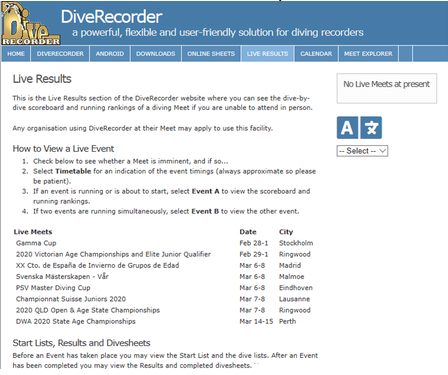
The ingenious part is that you can be sitting at home and watch the competitions progress. So… if your grandparents were unable to travel to your competition, they can look up Dive Recorder on the internet. They then look which competitions are being “broadcast live” They then look for yours. They then click on the live results tab, and watch your progress unfurl along with your rivals! No visual live action…yet
The judges hold electronic handsets and feed in their points for your dive. These not only show up on the recorders table but on a screen for the spectators to follow. As the recorders keep the running totals up to the second these are also automatically projected onto the screen. The spectators know how their children are performing all the way through the competition. This can produce some nail biting experiences – especially if they know their child diver needs a few extra points to beat you! As each round finishes the positions of the divers change nearly all the time. Nail biting especially occurs on the last round of dives when the final positions are calculated and set in stone!
UP
Competition Structure and a note about speed of somersaulting
Hurdling to the heights! Every one had a centre of balance. An imaginary dot inside your body between your hip bones. The red ball is your centre of balance. The further away your limbs and head is to your centre of balance the slower your will somersault or turn or spin! The closer your limbs are you will turn faster.
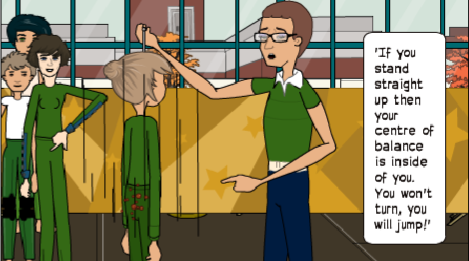
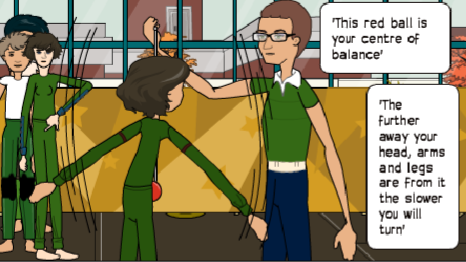
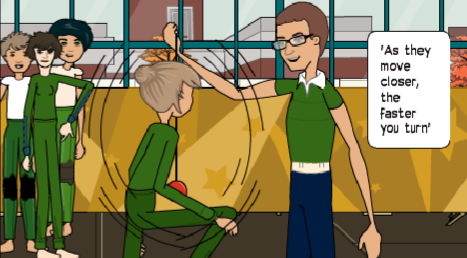
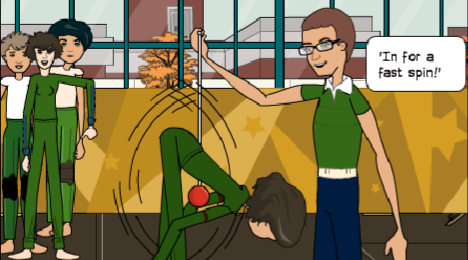
Competition structure generally has two sets of dives. The ultimate diving competition, the highest age group, or national or international level are required to perform ten dives for females, and 11 dives for males.
First set
The first set from ALL the the turning directions not exceeding a dive value (degree of difficulty) total when added together.
Second set
The second set from ALL the turning directions with the sky’s the limit as far as dive value ( degree of difficulty) is concerned. If you are good enough at ANY age then you have to conform to these requirements. Reminders below.
The idea behind restriction of the total dive value in the first set, is that the competitors are starting from an equal baseline. They are usually the easier dives with less dive value but show good basics, technique and control.
In general
In general as you are learning, the competition requirements are devised according to your age group. You could be performing anything between 2 to 5 dives in the first set, not exceeding a certain dive value total (degree of difficulty)
For the second set of the contest anything between 2 to 5 dives with degree of difficulty as high as you like. Also they must be performed from some or all of the turning directions (diving groups). Depending upon your age group it could be – a four dive competition or a 10 dive competition as mentioned above, or anything in between!

During your diving progress, you’ll be diving through the age groups, from club level up to county or regional level and then hurdling right up to national level! You’ll be diving against divers within your own age group.
Here is a recap of the official age group split for competition. 8-10 years; 11 – 13 years; 14 – 15 years; 16 -17 years; and seniors.
Competition structure is thus a good measure of your progress comparing your results with others. In some instances there are Junior and Senior Championships at these levels. At one time it used to be only this way – there weren’t age groups in past days.

Your coach may feel you are good enough to enter these. If you are a Junior (17 and under during the year of competition) then you may enter both Junior or Senior Championships! Obviously if you are over this age then it is just Senior Championships for you!
The championships may be run combined and the Junior winner extracted from the rest of the contenders. Sometimes it turns out the Junior comes away with both trophies!
Hurdling away to becoming good enough to compete at regional or national level, then you really are indeed becoming an excellent diver. Your hard work is paying off. They’re keeping an eye on you! The competition structure is such that it progresses your ability steadily and whilst you are training for one competition in all probability it will cover the requirements for another!
There are special talent scouts that look for potential champion material like you. You won’t see them or know of them, but they will have their eye on you. From what they see you could be invited to train in special squads – still with your own coach.
There are special training development schemes for day and weekend programmes, purely for planned training. You’ll be in the dry gym and the diving pool.
Standards have to be met regarding your stamina, fitness and strength, and all of these are assessed as you go along. These programmes can only benefit you, and one day – hurdling on to hold a few national titles you may be invited to represent your country in European Juniors, going up and up to the world championships and the ultimate goal… the Olympic Games! The sky’s the limit. They will be looking out for divers like you!
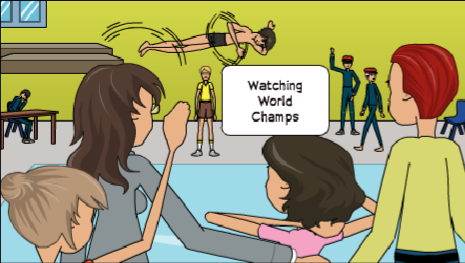
As part of your progression watch others’ diving in the World Championships or similar. Be awe-inspired during a day visit to competitions at these levels. You soon learn the excitement of which divers are tackling which dives. You’ll recognise who’s going to have a tough competition against who. Go along to national competitions in your early days followed by some international “meets”.
Sit back and enjoy the spectacle of the “elite” divers from the various countries competing against each other. You’ll soon catch “the hurdling towards new heights” bug!
UP
Synchronised diving
…is a spectacular event and is set to thrill
Synchronised diving first and foremost, is the spectacular invention of two divers diving as one!
History
Synchronised diving, a truly spectacular competition, was introduced into the Olympic Games in Athens in the year 2000. Two British boys won a silver medal! Peter Waterfield, and Leon Taylor who is none other than our regular TV unique; witty diving commentator. What a great honour for GB, and in this historic city too. The birth place of the Olympic Games. This awe-inspiring event is challenging, spectacular and very skilful…also good fun!
What is Synchronised Diving?
Synchronised diving is basically when two divers dive together from each of their boards. Their aim is to dive as one! The timing, the shape or body position, the distance from the board in the air, and the entry into the water should be the same.
Diving pools are constructed nowadays for holding this superb event. You may wonder why there are two 1m Springboards and two 3M springboards in the diving centres built today?
Also you may wonder why your diving pool is closed for a while? This may be because the 10M platform is being widened to take two divers at the same time.
The synchronised diving competitions are usually two males diving together, or two females. Today a recently mixed synchronised diving event has been introduced. It is what it says – a male and female diving together.
Your audience can’t help but catch their breath when your synchronised dives plunge down from the 10M highboard. You both of course finish with a “rip” entry, sucking the water down with you, hardly making a ripple. It makes the crowd want to jump up, shout and cheer.
Working together
You wear the same costumes; you practise over and over again; you take off from your own board and dive the same dive in time with your partner. Synchronised diving starts from both your approach’s to the end of the board – whether into a hurdle step, or taking up your starting positions for a backward or inward take off.
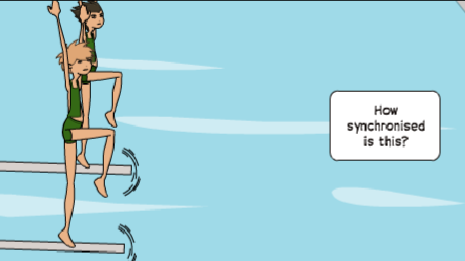
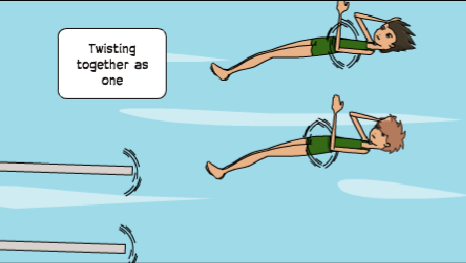
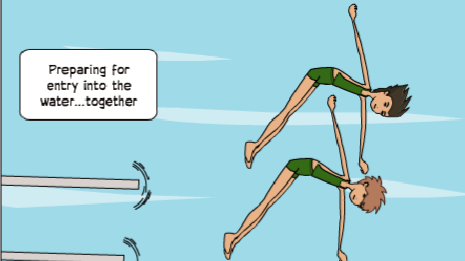
You may even develop the same mannerisms before starting your dives! For example you might wiggle your fingers when you are about to “go.” You might brush your hair out of your eyes together – whether it needs it or not! With your arms stretched down at the sides you could both move your elbows in and out until you feel a comfortable starting position. You might even make a final adjustment to your costumes!… and all this will be together… as one!
You choose which of you will give the signal to start walking down the board, either forwards into a hurdle step or towards a standing take off for backwards and inwards group. You keep in time with each other as if “you were one.”
How are the points awarded for Synchronised Diving?
There are nine judges. Five judges are allocated to each of you and judge the TECHNIQUE of your dives. The remaining four judges mark purely the synchronisation or “togetherness” of your dives. The judges will look at your take off from the board. Are you as one?
As well as your take off they look to see if you are the same distance away from the board, and also your height in the air. They analyse your movements as you somersault and twist – however complex or simple. Last of all they eye up your entry points into the water. Are they “whoosh” together through the water and in line with each other?
Progression
It’s breathtaking when divers “get it together.” It will take hours of practise using the dry gym and poolside. You’ll begin with jumps and take offs. After getting the timing good you will steadily move up the heights of diving boards and increase the number of half somersaults and half twists. Then …the 10 Metre highboard!
It’s interesting to note that a top synchronised diving partnership could be training miles away from each other. Each diver could be at opposite ends of the country . They are so good at their job. When they meet up in their events, they are perfect!
A good introduction to Synchronised Diving can be fun
You can take part in fun contests at club level. Usually winding up a club’s annual event/gala. This is to develop you, and the other divers, giving you chance to be inventive.
You can dress up as the latest gremlin, fairy, 007, or officers of the law. Although losing a tu tu or two, followed by tights, moustache and beard is hilarious. It does however have the serious element of preparing you for the future. Lots of spirit grows diving together as one!
As you move up and compete in regional competitions and above, then synchronised diving events become very serious.
UP
Cliff diving
One more step you could take!
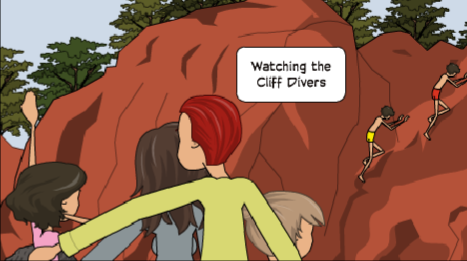
Cliff diving is awesome for competitive divers that want an extra thrill. Moving up to 18 – 26 metres high! they dive from the rocks or specially constructed platforms. You can find the platforms attached to bridges, cliffs, anywhere where there is a good depth of water, and investigated stringently for safety before it can become a designated competition venue.
There are groups of scuba divers in the water. They await near the point where the divers plunge down . The divers are travelling many miles per hour and any mistake could result in a nasty injury. The cliff divers have to be precise with their take offs from the rocks or platforms, ( and even someone’s back yard high up on the cliffs!). They need to be sure of their acrobatics in the air, and timing, in order to land safely FEET first through the water. Never from such heights are head first entries.
The scuba divers keep an eye under the water, as the divers plunge deep, to make sure that they are safe and sound.
It goes without saying that the cliff divers prepare their bodies and minds for such skills. They build up their muscles, strength and stamina. They are devoted to their well being. Many hours in the dry diving gym are spent practising twisting and somersaulting. A different mind set is necessary, and when it comes to the water, they progress slowly but surely, up towards the ultimate height laid down in the rules and regulations. As yet it is not an Olympic event. I believe there are discussions with FINA (already mentioned – the governing body of our aqua sports) so at some point it might well be included.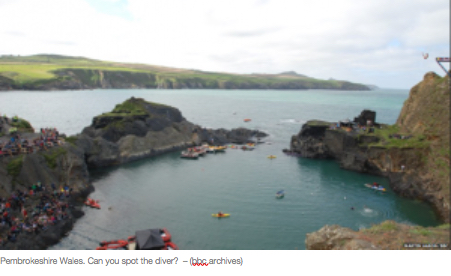 Pembrokeshire included in World Series Tournament
Pembrokeshire included in World Series Tournament
However Cliff diving IS a World event and divers from many countries compete against each other in a tournament known as the World Series. This event is moved from one country to another – in series – during a year, and the ultimate event together with their tally of scores from previous rounds, decide who is the all round World Champion. It is interesting to note that Pembrokeshire in Wales is one of the venues during the Series.
Just as requirements are laid out for all diving competitions, Cliff diving is no exception. A certain number of dives have to be performed from so many turning directions (Diving Groups), and the degree of difficulty added into their scores.
Cliff divers evolve usually from being once National and International divers, especially highboard/platform, from which their 10 metre platform training and events prepare a solid base to move higher- at least twice as high + – up onto the Cliffs. The divers get the taste for further challenge, and to win more Gold medals!
Cliff diving is thrilling and the event attracts thousands of spectators. You catch them decorating the rocks all around, in boats and on floating platforms, wherever there is a good vantage point there isn’t an inch of space unfilled. Together with the beautiful weather conditions , and spectacular vistas in all of the countries, it is indeed a wonderful weekend away and an awesome experience to watch the agility and talent of the daring Cliff Divers
Search Internet. Lots of coverage. Click to a video to utube https://youtu.be/NBzLLUcvR_o
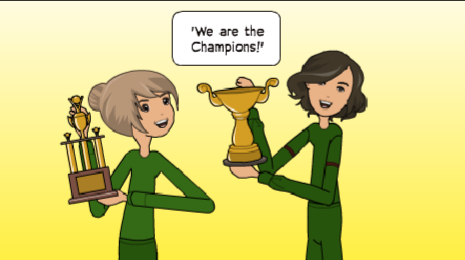 Most of all diving should be fun
Most of all diving should be fun
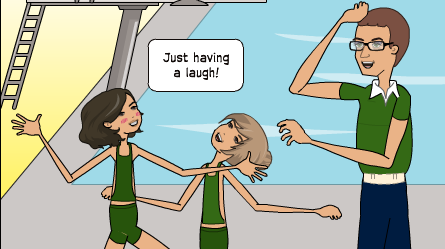
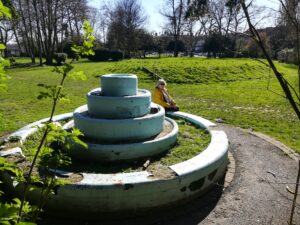
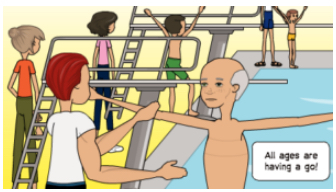
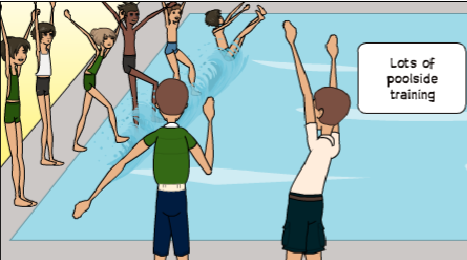
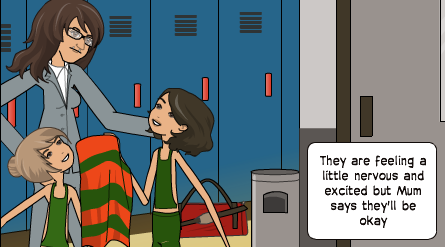
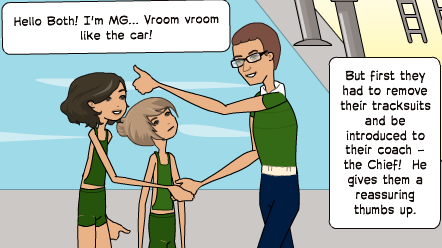
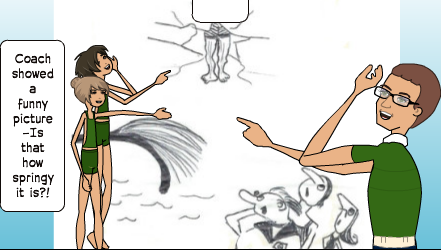
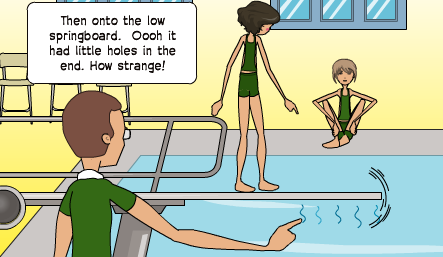
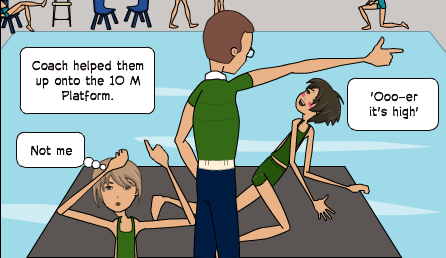
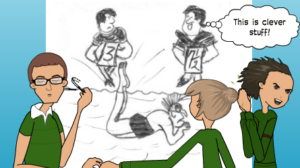
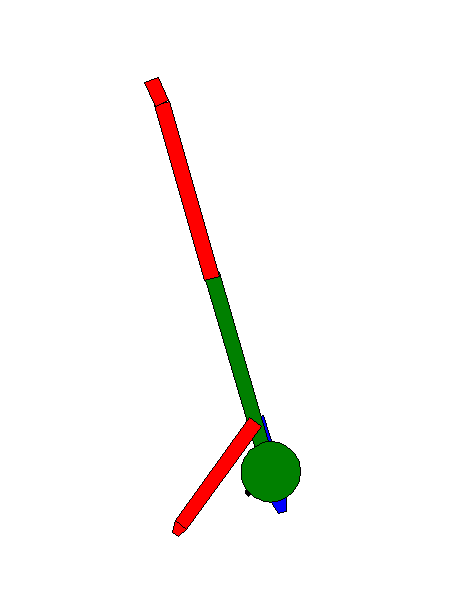
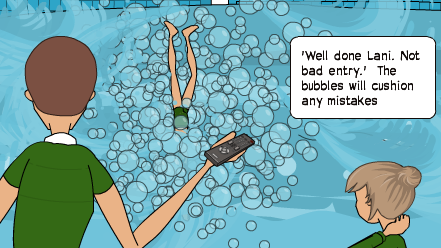
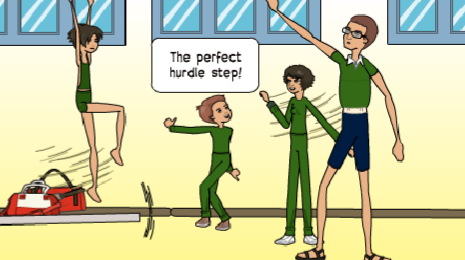
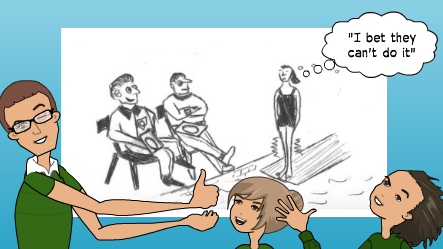
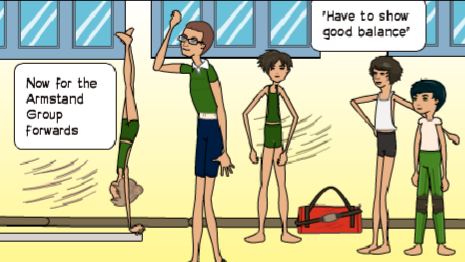
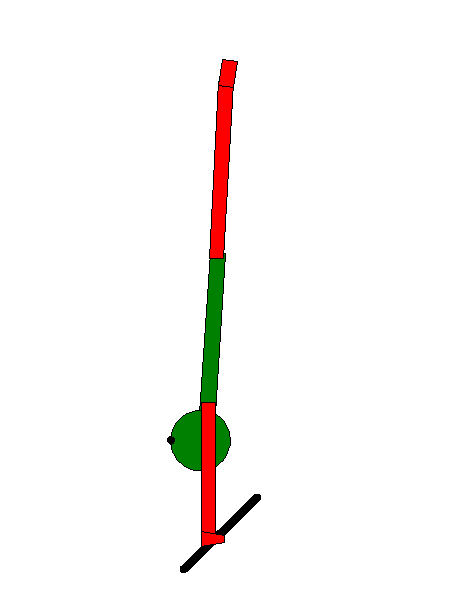
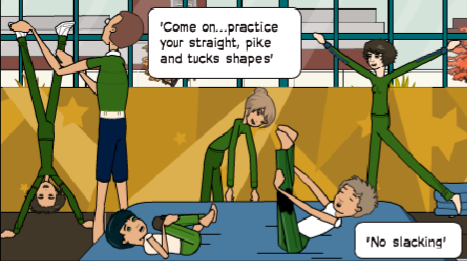
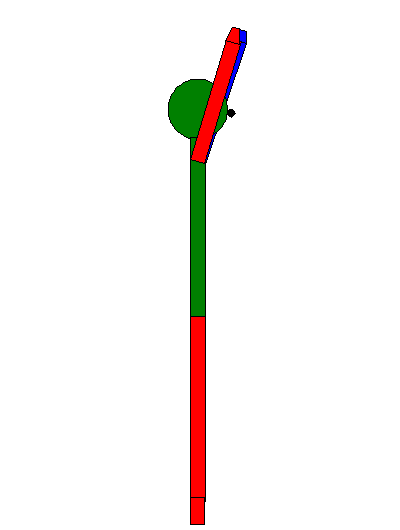
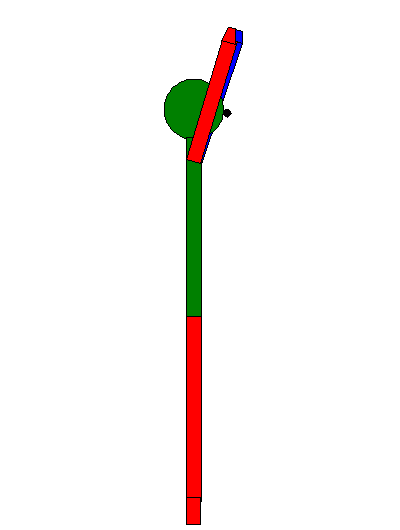
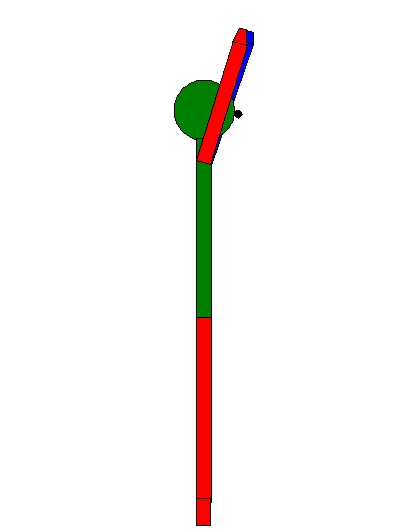
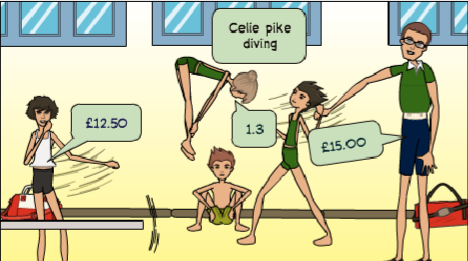
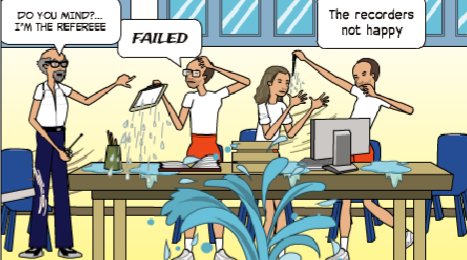

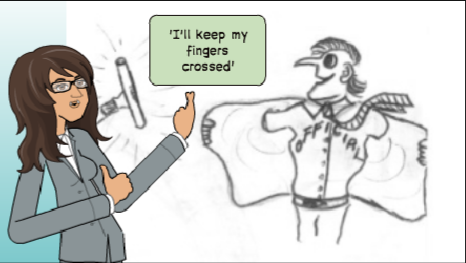
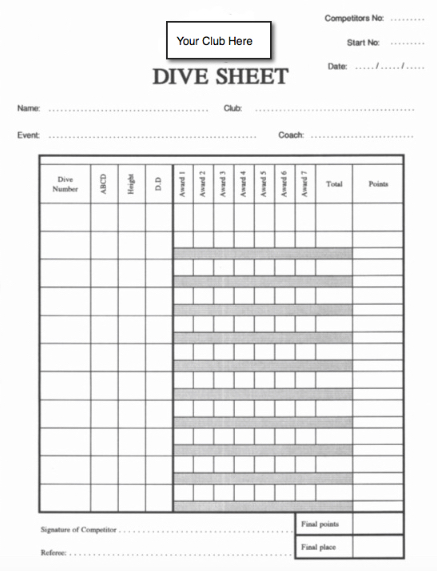
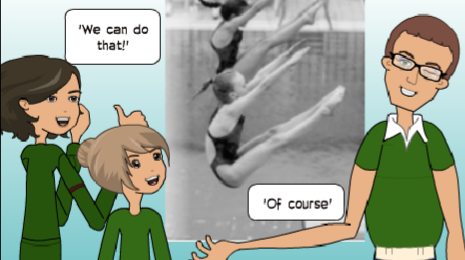


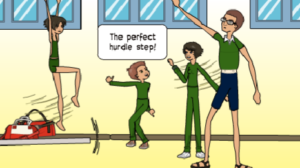
Most recent comments…